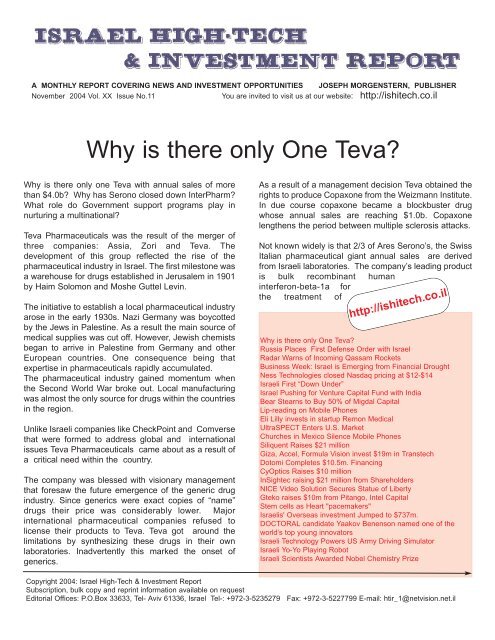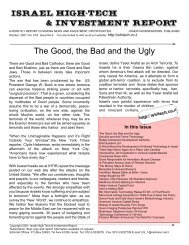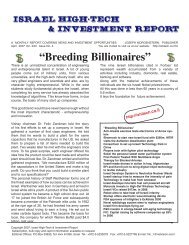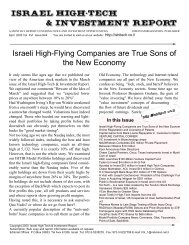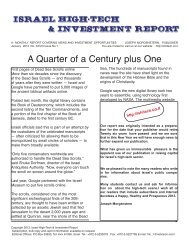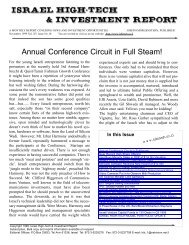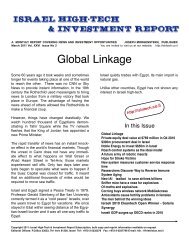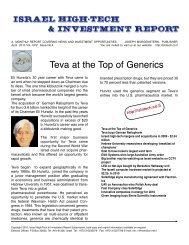Why is there only One Teva? - The Israel High Tech & Investment ...
Why is there only One Teva? - The Israel High Tech & Investment ...
Why is there only One Teva? - The Israel High Tech & Investment ...
You also want an ePaper? Increase the reach of your titles
YUMPU automatically turns print PDFs into web optimized ePapers that Google loves.
A MONTHLY REPORT COVERING NEWS AND INVESTMENT OPPORTUNITIES JOSEPH MORGENSTERN, PUBLISHER<br />
November 2004 Vol. XX Issue No.11<br />
You are invited to v<strong>is</strong>it us at our website: http://<strong>is</strong>hitech.co.il<br />
<strong>Why</strong> <strong>is</strong> <strong>there</strong> <strong>only</strong> <strong>One</strong> <strong>Teva</strong><br />
<strong>Why</strong> <strong>is</strong> <strong>there</strong> <strong>only</strong> one <strong>Teva</strong> with annual sales of more<br />
than $4.0b <strong>Why</strong> has Serono closed down InterPharm<br />
What role do Government support programs play in<br />
nurturing a multinational<br />
<strong>Teva</strong> Pharmaceuticals was the result of the merger of<br />
three companies: Assia, Zori and <strong>Teva</strong>. <strong>The</strong><br />
development of th<strong>is</strong> group reflected the r<strong>is</strong>e of the<br />
pharmaceutical industry in <strong>Israel</strong>. <strong>The</strong> first milestone was<br />
a warehouse for drugs establ<strong>is</strong>hed in Jerusalem in 1901<br />
by Haim Solomon and Moshe Guttel Levin.<br />
<strong>The</strong> initiative to establ<strong>is</strong>h a local pharmaceutical industry<br />
arose in the early 1930s. Nazi Germany was boycotted<br />
by the Jews in Palestine. As a result the main source of<br />
medical supplies was cut off. However, Jew<strong>is</strong>h chem<strong>is</strong>ts<br />
began to arrive in Palestine from Germany and other<br />
European countries. <strong>One</strong> consequence being that<br />
expert<strong>is</strong>e in pharmaceuticals rapidly accumulated.<br />
<strong>The</strong> pharmaceutical industry gained momentum when<br />
the Second World War broke out. Local manufacturing<br />
was almost the <strong>only</strong> source for drugs within the countries<br />
in the region.<br />
Unlike <strong>Israel</strong>i companies like CheckPoint and Comverse<br />
that were formed to address global and international<br />
<strong>is</strong>sues <strong>Teva</strong> Pharmaceuticals came about as a result of<br />
a critical need within the country.<br />
<strong>The</strong> company was blessed with v<strong>is</strong>ionary management<br />
that foresaw the future emergence of the generic drug<br />
industry. Since generics were exact copies of “name”<br />
drugs their price was considerably lower. Major<br />
international pharmaceutical companies refused to<br />
license their products to <strong>Teva</strong>. <strong>Teva</strong> got around the<br />
limitations by synthesizing these drugs in their own<br />
laboratories. Inadvertently th<strong>is</strong> marked the onset of<br />
generics.<br />
As a result of a management dec<strong>is</strong>ion <strong>Teva</strong> obtained the<br />
rights to produce Copaxone from the Weizmann Institute.<br />
In due course copaxone became a blockbuster drug<br />
whose annual sales are reaching $1.0b. Copaxone<br />
lengthens the period between multiple scleros<strong>is</strong> attacks.<br />
Not known widely <strong>is</strong> that 2/3 of Ares Serono’s, the Sw<strong>is</strong>s<br />
Italian pharmaceutical giant annual sales are derived<br />
from <strong>Israel</strong>i laboratories. <strong>The</strong> company’s leading product<br />
<strong>is</strong> bulk recombinant human<br />
interferon-beta-1a for<br />
the treatment of<br />
http://<strong>is</strong>hitech.co.il<br />
<strong>Why</strong> <strong>is</strong> <strong>there</strong> <strong>only</strong> <strong>One</strong> <strong>Teva</strong><br />
Russia Places First Defense Order with <strong>Israel</strong><br />
Radar Warns of Incoming Qassam Rockets<br />
Business Week: <strong>Israel</strong> <strong>is</strong> Emerging from Financial Drought<br />
Ness <strong>Tech</strong>nologies closed Nasdaq pricing at $12-$14<br />
<strong>Israel</strong>i First “Down Under”<br />
<strong>Israel</strong> Pushing for Venture Capital Fund with India<br />
Bear Stearns to Buy 50% of Migdal Capital<br />
Lip-reading on Mobile Phones<br />
Eli Lilly invests in startup Remon Medical<br />
UltraSPECT Enters U.S. Market<br />
Churches in Mexico Silence Mobile Phones<br />
Siliquent Ra<strong>is</strong>es $21 million<br />
Giza, Accel, Formula V<strong>is</strong>ion invest $19m in Transtech<br />
Dotomi Completes $10.5m. Financing<br />
CyOptics Ra<strong>is</strong>es $10 million<br />
InSightec ra<strong>is</strong>ing $21 million from Shareholders<br />
NICE Video Solution Secures Statue of Liberty<br />
Gteko ra<strong>is</strong>es $10m from Pitango, Intel Capital<br />
Stem cells as Heart "pacemakers"<br />
<strong>Israel</strong><strong>is</strong>' Overseas investment Jumped to $737m.<br />
DOCTORAL candidate Yaakov Benenson named one of the<br />
world’s top young innovators<br />
<strong>Israel</strong>i <strong>Tech</strong>nology Powers US Army Driving Simulator<br />
<strong>Israel</strong>i Yo-Yo Playing Robot<br />
<strong>Israel</strong>i Scient<strong>is</strong>ts Awarded Nobel Chem<strong>is</strong>try Prize<br />
Copyright 2004: <strong>Israel</strong> <strong>High</strong>-<strong>Tech</strong> & <strong>Investment</strong> Report<br />
Subscription, bulk copy and reprint information available on request<br />
Editorial Offices: P.O.Box 33633, Tel- Aviv 61336, <strong>Israel</strong> Tel-: +972-3-5235279 Fax: +972-3-5227799 E-mail: htir_1@netv<strong>is</strong>ion.net.il
November 2004<br />
Multiple Scleros<strong>is</strong> (MS). Manufactured by InterPharm<br />
and Serono, the product <strong>is</strong> marketed under the<br />
Rebif® commercial brand name. <strong>The</strong> second<br />
product came about from research dating from the<br />
1960s by a young scient<strong>is</strong>t named Aliza Eshkol, who<br />
worked at the gland research laboratories at <strong>Israel</strong>’s<br />
Tel Hashomer Medical Center. <strong>The</strong> resulting product<br />
Gonal-F, generates 26% of Serono's annual<br />
revenues.<br />
By a small stretch of the imagination, Serono’s recent<br />
dec<strong>is</strong>ion to close down InterPharm in <strong>Israel</strong> and to<br />
transfer it to Italy, <strong>is</strong> understandable.. By moving<br />
InterPharm to Serono, in due course, the <strong>Israel</strong>i origin<br />
and the drugs developed <strong>there</strong> will be erased.<br />
However, that doesin no way detracta from the<br />
remarkable technological capabilities of <strong>Israel</strong>’s<br />
biotechnology researchers.<br />
Government support programs in today’s world are a<br />
must and should not be an <strong>is</strong>sue for foreign<br />
companies seeking to gain a foothold in <strong>Israel</strong>.<br />
<strong>The</strong> research and development commercialization<br />
companies, affiliated with th<strong>is</strong> country’s major<br />
universities, have available billions of dollars of knowhow.<br />
<strong>The</strong>y are unable to find enough licensees in<br />
<strong>Israel</strong> and would be more than happy to license their<br />
patents to overseas groups.<br />
Perhaps in the final analys<strong>is</strong> as to why <strong>there</strong> <strong>is</strong> <strong>only</strong><br />
one <strong>Teva</strong>, can be gleaned from the company’s<br />
h<strong>is</strong>tory. Its products were desperately needed by a<br />
Middle Eastern population that could not obtain drugs<br />
from overseas. It <strong>is</strong> also likely that today’s <strong>Israel</strong>i<br />
entrepreneur does not dream of being an Eli Hurwitz,<br />
but would be more likely to emulate the founders of<br />
Mirabil<strong>is</strong> or ICQ who built businesses in a few years<br />
and rapidly cashed out in the hundreds of millions of<br />
dollars.<br />
Russia Places First Defense Order<br />
with <strong>Israel</strong><br />
Hebrew daily “Yediot Ahronot” reports that Russia<br />
has made its first defense purchase from <strong>Israel</strong>.<br />
Aeronautics Defense Systems has signed a contract<br />
with the Russian company Irkut, the manufacturer of<br />
the advanced fighter-bomber Sukhoi Su-30, for<br />
unmanned aerial vehicles (UAV) valued at several<br />
millions of dollars. Russia's Min<strong>is</strong>try of Civil Defense<br />
approved the transaction. Defense Systems’ Vice-<br />
President of marketing, Idan Shimon confirmed the<br />
report.<br />
Aeronautics Defense Systems, located near Tel-Aviv<br />
will supply the company’s Aerostar UAV. <strong>The</strong> product<br />
has also been sold to Angola, Ivory Coast and other<br />
African countries. Aerostar <strong>is</strong> used to defend oil<br />
installations and other facilities.<br />
Aeronautics Defense Systems recently achieved a<br />
milestone when it signed a joint-venture agreement<br />
for UAVs with the General Dynamics Corp.<br />
(NYSE:GD). <strong>The</strong> agreement has already led to one<br />
contract: the US Navy has bought several of<br />
Aeronautics Defense Systems' products. <strong>The</strong><br />
Aerostar <strong>is</strong> manufactured in the US, which Shimon<br />
says enables the IDF to use US military aid to buy the<br />
system.<br />
In order to expand its share of the UAV market,<br />
Aeronautics Defense Systems bought most of the<br />
shares of Italian UAV engine-maker Zanzottera<br />
<strong>Tech</strong>nologies earlier th<strong>is</strong> year. Zanzottera <strong>is</strong> now in<br />
the process of developing more powerful engines for<br />
Aeronautics Defense Systems larger UAVs, now<br />
under development.<br />
<strong>Israel</strong> <strong>High</strong>-<strong>Tech</strong> & <strong>Investment</strong> Report<br />
Publ<strong>is</strong>hed monthly since January 1985<br />
Publ<strong>is</strong>her and Editor in Chief<br />
Joseph Morgenstern, B.A. Chem.<br />
<strong>Tech</strong>nology Review Board<br />
Prof. S.J. Joel-Cohen, MD, FRCS. FRCOG (1996-2002)<br />
Prof. Hylton Miller, M.B. Ch.B.<br />
Dr. Clive L. Carpel, M.B. Ch.B.<br />
Copy Chief<br />
Debbie Mor<br />
Web Master<br />
Marty vonBokel<br />
Graphics Consultant<br />
Daniel Morgenstern<br />
Subscription Inquiries<br />
Tel-. +972-3-5235279 Fax. +972 3-5227799<br />
E-mail: htir_1@netv<strong>is</strong>ion.net.il<br />
Annual subscription $95.- per year, for 11 <strong>is</strong>sues,<br />
<strong>Israel</strong>i residents add 18% VAT<br />
Web Edition and Achives<br />
http://<strong>is</strong>hitech.co.il<br />
2
November 2004<br />
Radar Warns of Incoming Qassam<br />
Rockets<br />
Residents in Jew<strong>is</strong>h settlements in the Gaza strip will<br />
soon begin to benefit from a novel technology that<br />
affords residents a 15 to 20 second warning of an<br />
incoming Qassam rocket fired from Gaza.<br />
<strong>The</strong> system, which <strong>is</strong> connected to a public address<br />
system, was used recently for the first time and<br />
observers judged it to be successful.<br />
Known as Maamin, Hebrew for “I believe”, the system<br />
fixes the position from which a rocket <strong>is</strong> fired and<br />
<strong>is</strong>sues a warning. Using electro-optic sensors and<br />
advanced computers, Maamin <strong>is</strong> capable of<br />
pinpointing both the location of the launch and the<br />
point where the m<strong>is</strong>sile will land, in a calculation<br />
lasting. less than a second.<br />
<strong>The</strong> m<strong>is</strong>sile div<strong>is</strong>ion at Rafael <strong>Israel</strong> Armament<br />
Development Authority, developed the system and a<br />
prototype was built in six weeks following an<br />
emergency request.<br />
Maamin was developed according to specifications of<br />
the ground forces for locating snipers. Success in the<br />
development stages led to an expansion of the<br />
specifications to locating the launch sites of Qassam<br />
rockets.<br />
According to the IDF estimates, the average flight time<br />
of a Qassam <strong>is</strong> about 30 seconds, which <strong>is</strong> long<br />
enough to seek cover, according to military sources.<br />
<strong>The</strong> IDF expects to expand the capabilities of the<br />
system to enable an immediate response against<br />
those firing the rockets.<br />
Rafael CEO Giora Shalgi said the system <strong>is</strong> relatively<br />
simple. He said that with a small investment of less<br />
than $10 million it would be possible to broaden the<br />
system to cover the northern border and the Gaza<br />
Strip. According to the police officers 101 Qassam<br />
rockets have been fired so far th<strong>is</strong> year. Thirteen<br />
rockets were the upgraded Nasser 3, which has a<br />
longer range and larger warhead.<br />
Business Week: “<strong>Israel</strong> <strong>is</strong> Emerging<br />
from Financial Drought”<br />
“<strong>Israel</strong>’s high-tech sector finally <strong>is</strong> emerging from a<br />
long financial drought… <strong>The</strong> global recovery has<br />
energized <strong>Israel</strong>’s so-called ‘silicon wad<strong>is</strong>’,” stated<br />
Business Week in a recently publ<strong>is</strong>hed feature article.<br />
“<strong>The</strong>re <strong>is</strong> a buzz on the streets of Tel-Aviv about<br />
several of the major global technology players that are<br />
on the verge of cutting deals in the next few weeks.”<br />
“<strong>Why</strong> the renewed interest in <strong>Israel</strong> First, for a small<br />
country, <strong>Israel</strong> has lots of start-ups. And start-ups,<br />
unlike Western tech giants, didn’t have the luxury of<br />
cutting back R&D to get through the downturn. So the<br />
<strong>Israel</strong><strong>is</strong> kept innovating, even as the global tech<br />
industry swooned, and fighting surged between<br />
<strong>Israel</strong><strong>is</strong> and Palestinians,” writes Business Week.<br />
”Now <strong>there</strong> are lots of small survivors with leadingedge<br />
technology in areas such as Internet security,<br />
wireless broadband, and medical devices. No wonder<br />
acqu<strong>is</strong>ition activity <strong>is</strong> up by some 25% over the past<br />
year. <strong>Tech</strong> exports surged 20% in the first six months<br />
of 2004, to more than $6 billion, and the Tel-<strong>Tech</strong> 15<br />
index <strong>is</strong> up 48% in the past twelve months.<br />
”<strong>Israel</strong>i high-tech companies are also returning to Wall<br />
Street, after a long hiatus. So far th<strong>is</strong> year, three outfits<br />
Lipman Electronics Engineering (Nasdaq: LPMA;<br />
TASE: LPMA), which develops electronic payment<br />
systems; PowerDsine (Nasdaq: PDSN), a maker of<br />
integrated circuits for telecoms; and Syneron Medical<br />
(Nasdaq: ELOS) have joined the 70 plus local hightech<br />
outfits traded on Nasdaq,” Business Week points<br />
out.<br />
”<strong>The</strong>re are at least a half-dozen initial public offerings,<br />
and a number of follow-on offerings ready to go to<br />
market by the end of the year,” Lehman Brothers<br />
managing director and head of <strong>Israel</strong>i business<br />
Leonard G. Rosen was quoted as saying.<br />
<strong>The</strong> number of financing deals <strong>is</strong> increasing but 17 of<br />
31 deals in the past year have been for less than $10<br />
million. Apparently a similar situation <strong>is</strong> developing<br />
with new public offerings.<br />
Ness <strong>Tech</strong>nologies Debuts on Nasdaq<br />
Tel Aviv-based software services Ness <strong>Tech</strong>nologies<br />
(Nasdaq:NSTC) completed one of the largest initial<br />
public offerings by an <strong>Israel</strong>i firm on Nasdaq in years.<br />
Its pricing phase was a bit d<strong>is</strong>appointing for the<br />
company, which wound up ra<strong>is</strong>ing less than expected.<br />
But it was still the most impressive offering by an<br />
<strong>Israel</strong>i company on Wall Street for a long time.<br />
<strong>The</strong> final range was $12 to $14, meaning the company<br />
ra<strong>is</strong>ed between $90 million to $105 million. <strong>The</strong> firm<br />
had hopes to ra<strong>is</strong>e $120m. but settled for a lower than<br />
anticipated offering pricing.<br />
Some of its shareholders, including the Wolfson family<br />
and Warburg Pincus, decided to participate in the IPO.<br />
3
November 2004<br />
<strong>The</strong>y reg<strong>is</strong>tered to sell 4.1 million shares.<br />
<strong>The</strong> offering was handled by Lehman Brothers and<br />
Merrill Lynch. <strong>The</strong> underwriters have a green-shoe<br />
option to buy another 1.75 million shares. Altogether<br />
Ness and its shareholders should realize just under<br />
$200 million from the offering, which prices Ness at<br />
almost half a billion dollars.<br />
Ness <strong>Tech</strong>nologies <strong>is</strong> an amalgamation of <strong>Israel</strong>i and<br />
foreign software houses. Ness reported secondquarter<br />
revenues of $73.9 million, an increase of 65%<br />
compared with the parallel quarter of 2003 and up 4%<br />
from the first quarter.<br />
First-half sales totalled $145 million, an increase of<br />
57% from the same six months of 2003.<br />
Second-quarter operating profit was $4.3 million,<br />
versus an operating loss of $17,000 in the parallel<br />
quarter of 2003. But in the first quarter, it had achieved<br />
operating profit of $5.2 million.<br />
It netted $2.9 million in the second quarter of 2004,<br />
more than 200% its earnings in the parallel quarter and<br />
comparing with $2.4 million profit in the first quarter of<br />
the year.<br />
First-half net profit reached $5.3 million, and cash flow<br />
from operations was $8.8 million. At the end of the<br />
second quarter, Ness had $43.5 million cash.<br />
On the first day of trading the Ness shares gained 7%<br />
over their <strong>is</strong>sue price.<br />
<strong>Israel</strong> Debuts “Down Under”<br />
Denx, a Jerusalem based a surgical technology<br />
company, chose the Australian Stock Exchange for its<br />
recent stock market debut, a backdoor l<strong>is</strong>ting through<br />
the investment company Helm Corporation.<br />
Helm <strong>is</strong> associated with Graeme Holt, an Australian<br />
investor. <strong>The</strong> founder and chief executive of Denx,<br />
Alon Hayka, says its l<strong>is</strong>ting in Australia could trigger<br />
similar moves by other <strong>Israel</strong>i technology companies.<br />
He says <strong>Israel</strong>i companies struggling with the<br />
downturn in the technology industry are searching the<br />
world for finance, and the l<strong>is</strong>ting in Australia offered<br />
Denx the opportunity to widen its shareholder base.<br />
“Our story has not received much attention in Australia<br />
to date but it certainly got attention in <strong>Israel</strong>,” he says.<br />
“<strong>Israel</strong>i technology companies have always looked to<br />
NASDAQ or special<strong>is</strong>t European technology markets<br />
for capital. Th<strong>is</strong> <strong>is</strong> the first time anyone from <strong>Israel</strong> has<br />
tried Australian equity markets. We have had dozens<br />
of inquiries from other technology companies and<br />
venture capital groups concerning our l<strong>is</strong>ting.”<br />
Denx employs 70 people, making proprietary surgery<br />
navigation technology. It <strong>is</strong> used by special<strong>is</strong>t dent<strong>is</strong>ts<br />
and in dental training schools. “In essence, the<br />
technology allows dent<strong>is</strong>ts to see their location in the<br />
bone in which they are drilling,” says Hayka, who<br />
establ<strong>is</strong>hed Denx in 1994 and owns 9% of the<br />
company.<br />
<strong>Israel</strong> Promoting Venture Capital Fund<br />
with India<br />
<strong>The</strong> Government of <strong>Israel</strong> <strong>is</strong> in talks with the Indian<br />
Government to set up a joint Venture Capital fund to<br />
aid Indo-<strong>Israel</strong>i technology ventures.<br />
Mouneer Agbariya, the First Secretary, of Economic<br />
Affairs, Embassy of <strong>Israel</strong> speaking to the media in<br />
Bangalore said: “We have had a series of d<strong>is</strong>cussions<br />
with the Government of India to set up th<strong>is</strong> fund which<br />
will focus on technology companies based on<br />
collaboration between Indian and <strong>Israel</strong>i companies.”<br />
He further added that with India's software services<br />
expert<strong>is</strong>e and <strong>Israel</strong>'s high-tech background,<br />
companies formed with th<strong>is</strong> partnership, will become a<br />
potent force in the industry.<br />
Stressing the need for such a fund, he said that <strong>Israel</strong><br />
has a leading edge in information and<br />
telecommunication technologies, continually attracting<br />
the world's attention and attaining a position among<br />
the top three competence centers worldwide.<br />
He also highlighted the fact that Indian technology<br />
companies could benefit from participating in the<br />
forthcoming 'Telecom <strong>Israel</strong> 2004', a bi-annual telecom<br />
exhibition and conference.<br />
Bear Stearns to Buy 50% of Migdal<br />
Capital<br />
According to Haaretz’s business magazine <strong>The</strong><br />
Marker, Migdal Insurance (TASE: MGDL ) <strong>is</strong> about to<br />
sign an agreement to sell 50% of Migdal Capital<br />
Markets to Bear Stearns, . <strong>The</strong> transaction will<br />
apparently price Migdal Capital Markets at about $22.3<br />
million.<br />
<strong>The</strong> insurance giant <strong>is</strong> preparing the groundwork for<br />
the banks' anticipated, and forced, sale of their<br />
provident and mutual funds holdings.<br />
Migdal Capital Markets provides portfolio management<br />
and trading services, investment advice and<br />
underwriting services. It also engages in management<br />
of provident and mutual funds, and <strong>is</strong> considered one<br />
of the biggest mutual fund managers outside the<br />
banking system.<br />
4
Novemberr 2004<br />
Bear Stearns, the sixth-biggest investment bank in<br />
the U.S., has previously been active in <strong>Israel</strong> in<br />
arranging investments.<br />
Lip-reading on Mobile Phones<br />
<strong>Israel</strong>'s largest mobile phone operator Cellcom and<br />
<strong>Israel</strong>i start-up SpeechView have launched a<br />
worldwide-patented software that will allow the deaf<br />
and hard of hearing to communicate verbally through<br />
mobile phones.<br />
Ra<strong>is</strong>ing the level of lip reading <strong>is</strong> achieved by creating<br />
cued speech which<br />
can be thought of as<br />
enhanced lipreading<br />
-- signs are<br />
made around the<br />
face that appear on<br />
the computer<br />
screen to provide<br />
vital additional<br />
information about<br />
some of the<br />
phonemes being<br />
uttered. A company executive points out that lipreading<br />
<strong>is</strong> usually a practical means of<br />
communication, but <strong>is</strong> not perfect-- typically, a person<br />
who <strong>is</strong> lip-reading <strong>only</strong> recognizes 30 per cent of the<br />
words being uttered. For example, b and p cannot be<br />
told apart -- and thus ``cued speech'' indicates which<br />
phoneme <strong>is</strong> being uttered. <strong>The</strong> enhancement of the<br />
moving lips <strong>is</strong> achieved with algorithms, and in the<br />
final software, allows for the deaf person to maintain<br />
conversation, nearly seamlessly, a conversation<br />
which begins with the speech of the caller and its<br />
understanding by the handicapped person, as he<br />
v<strong>is</strong>ually observes and reads the conversation that<br />
has been converted into a lip readable format. <strong>The</strong><br />
software product trade named LipCcell, <strong>is</strong> installed in<br />
the user's computer and connected with a cable to a<br />
cellphone. When the deaf person receives a call, the<br />
software translates the voice on the other side of the<br />
line into a three-dimensional animated face on the<br />
computer, whose lips move in real time synch with the<br />
voice allowing the receiver of the call to lip read.<br />
A company executive said he knows of no such<br />
technology in the world, and added that SpeechView<br />
was in touch with mobile phone operators in Great<br />
Britain, Belgium and the Netherlands to further<br />
d<strong>is</strong>tribute the product.<br />
"<strong>The</strong>re <strong>is</strong> no language limitation," he said, adding that<br />
all phonemic languages can be translated by the<br />
software.<br />
<strong>The</strong> technology was created by Nachshon Margaliot,<br />
an <strong>Israel</strong>i information systems special<strong>is</strong>t, who<br />
stumbled upon the need for the product while working<br />
with a hard of hearing colleague.<br />
"I couldn't understand how the communication world<br />
had forgotten the hard of hearing and why <strong>there</strong> was<br />
no comprehensive solution," Margaliot said.<br />
A spokesman for SpeechView said that 10 percent of<br />
the world population had different levels of hearing<br />
difficulties, of which half were suited to use the<br />
software.<br />
Eli Lilly invests in Startup Remon<br />
Medical<br />
In July 2003 IHTIR featured Caesarea based Remon<br />
Medical <strong>Tech</strong>nologies as a highly interesting medical<br />
startup. <strong>The</strong> company recently announced that it has<br />
completed a $16 million financing round, led by Lilly<br />
Ventures, the investment arm of Eli Lilly, and KBL<br />
Healthcare Ventures. <strong>The</strong> Ofer Brothers and ex<strong>is</strong>ting<br />
shareholders, including the U.S. fund Polar<strong>is</strong> Venture<br />
Partners and Concord Ventures of <strong>Israel</strong>, also<br />
participated inthe<br />
financing.<br />
Remon has<br />
pioneered the first<br />
human use of an<br />
implantable intravascular<br />
wireless<br />
telemetric<br />
communication<br />
system. Former<br />
<strong>Israel</strong>i naval<br />
officers, who<br />
applied ultrasound<br />
sonar concepts in submarines, developed the<br />
company’s technology.<br />
<strong>The</strong> Remon ImPressure offers on-demand, noninvasive<br />
means to monitor intra- vascular pressures,<br />
following endo-vascular graft procedures. <strong>The</strong><br />
company says it has fin<strong>is</strong>hed enrolling patients for<br />
clinical trials of its system. <strong>The</strong> device was developed<br />
in collaboration with Guidant Corporation, which<br />
focuses on technology for treat -ing cardiac and<br />
vascular d<strong>is</strong>eases.<br />
Remon was establ<strong>is</strong>hed in 1999 in the Ofer Brothers'<br />
5
November 2004<br />
technology incubator. In 2001 Remon ra<strong>is</strong>ed $10<br />
million at a post-money company valuation of $30<br />
million.<br />
UltraSPECT Enters U.S. Market<br />
Haifa-based UltraSPECT has announced 15<br />
installations of its systems in top-tier U.S. and <strong>Israel</strong>i<br />
hospitals. In <strong>Israel</strong>, its products have been installed at<br />
Hadassah Medical Center in Jerusalem and the<br />
Carmel Medical Center in Haifa. <strong>The</strong> contracts for its<br />
devices are valued at about half a million dollars.<br />
<strong>The</strong> company’s technology enables gamma cameras<br />
to provide greater productivity and superior image<br />
quality.<br />
Sales, of its key products Xact.bone and Xpress.bone<br />
which began in June, according to company reports,<br />
exceed expectations. Both products shorten the<br />
duration of the imaging process, for the convenience<br />
of the patient and improve the efficiency and turnover<br />
of the highly expensive imaging devices.<br />
Both devices have received United States Food and<br />
Drug Admin<strong>is</strong>tration clearance.<br />
UltraSPECT says its wide beam reconstruction<br />
technology improves the detectability of lesions, and<br />
reduces scan times by as much as 50% without<br />
comprom<strong>is</strong>ing imaging quality. Contrast and<br />
resolution can be improved by a factor of two,<br />
compared to the current available technologies, the<br />
company stated.<br />
UltraSPECT, a privately held company establ<strong>is</strong>hed in<br />
late 1999, was founded by Dr. Shuli C. Shwartz<br />
(CEO) and Dr. <strong>Israel</strong> Ohana.<br />
UltraSPECT has three patents pending. It was one of<br />
three companies nationwide that won "<strong>The</strong> best<br />
technology incubator project" for the year 2003.<br />
Since its founding UltraSPECT has ra<strong>is</strong>ed about $4<br />
million in venture financing from Veritas, Giza, and<br />
private investor including Jonathan Adereth, and Hillel<br />
Bachrach, a co-founder of Lumen<strong>is</strong><br />
(Nasdaq:LUME.PK). <strong>The</strong> company <strong>is</strong> presently in<br />
preliminary talks alliances with leading medical<br />
imaging companies including GE Medical, Philips,<br />
and Siemens.<br />
Churches in Mexico Silence Mobile<br />
Phones<br />
Some Mexican churches are using state-of-the-art<br />
technology developed by <strong>Israel</strong>i electronic warfare<br />
experts to silence phones that ring during mass.<br />
Four churches in the northern Mexican city of<br />
Monterey are using equipment made by <strong>Israel</strong>i<br />
telecoms equipment firm Netline Communications<br />
<strong>Tech</strong>nologies to block calls during services.<br />
<strong>The</strong> Tel Aviv-based company was set up in 1998 by<br />
former military and defense industry special<strong>is</strong>ts to<br />
develop a hand phone jamming system, primarily for<br />
the security industry.<br />
Mr. Bulmaro Carranza, a caretaker at the city's<br />
Baroque-style Sacred Heart church, was quoted as<br />
saying: 'Before we had the system, it was very<br />
uncomfortable hearing calls coming in during the<br />
celebration of mass. 'Now, it's 95 per cent quiet.'<br />
<strong>The</strong> signal-jamming equipment <strong>is</strong> packed into two<br />
wall-mounted boxes the size of small hi-fi speakers,<br />
with one next to the altar and the other at the church<br />
entrance.<br />
Switched on just before the start of every service, the<br />
system causes a 'no signal' message to be d<strong>is</strong>played<br />
on worshippers' phones, but causes them no lasting<br />
damage.<br />
“We believe that we were the first church in Mexico to<br />
use th<strong>is</strong> technology,” Mr. Carranza said.<br />
“Now, we are getting calls from all over the country to<br />
see how it can be installed in other locations,” he<br />
added.<br />
Predix Pharmaceuticals Ra<strong>is</strong>ing $15m<br />
Predix Pharmaceuticals a US-<strong>Israel</strong>i start-up has<br />
announced the completion of two Phase I clinical<br />
studies, for its proprietary investigational drug, for the<br />
treatment of anxiety, depression and hyperactivity.<br />
<strong>The</strong> company plans to launch Phase II clinical trials<br />
for the drug. Predix uses proprietary 3D<br />
computational chem<strong>is</strong>try technologies with traditional<br />
medicinal chem<strong>is</strong>try, to create a drug d<strong>is</strong>covery<br />
platform.<br />
Predix was founded by Dr. Silvia Noiman, Dr. Oren<br />
Becker and Dr. Haim Aviv in 2000. Its main investors<br />
are <strong>Israel</strong>'s Yozma and Orbimed Adv<strong>is</strong>ors of the US.<br />
Predix has ra<strong>is</strong>ed $27 million to date and <strong>is</strong> currently<br />
ra<strong>is</strong>ing $15 million. Predix's drug, PRX-00023, <strong>is</strong> one<br />
6
Novemberr 2004<br />
of a new group of serotonin receptors d<strong>is</strong>covered<br />
using proprietary technology developed by Becker at<br />
Tel Aviv University.<br />
Siliquent ra<strong>is</strong>es $21 million<br />
<strong>The</strong> U.S. venture capital fund, Thomas We<strong>is</strong>el<br />
Ventures, was the lead investor in a $21 million<br />
financing round just completed by <strong>Israel</strong>i startup<br />
Siliquent. <strong>The</strong> company develops high-speed<br />
communications processors for storage networks. Its<br />
technology achieves speeds from 4 to 10 gigabits per<br />
second. Its solutions are applicable to iSCSI, RDMA<br />
and TCP/IP protocol, and are embedded in a single<br />
chip.<br />
Amit Oren and Dan Arazi establ<strong>is</strong>hed the company, in<br />
October 2000. To date the startup has ra<strong>is</strong>ed $40<br />
million, including money from IBM. It has 40<br />
employees at its Ramat Gan, <strong>Israel</strong> development<br />
center and at its California headquarters.<br />
Transtech Ra<strong>is</strong>e an Additional $19m<br />
Giza Venture Capital, Accel Partners, and Formula<br />
V<strong>is</strong>ion <strong>Tech</strong>nologies (TASE:FVT) are investing $19<br />
million in airfield management systems company<br />
Transtech Control, in return for 47% of the company.<br />
Giza Venture Capital led the financing round.<br />
Transtech’s system, the Intelligent Airport, provides<br />
tower controllers, airline ramp managers and airport<br />
operators with a real time d<strong>is</strong>play of traffic across the<br />
airport operating area. <strong>The</strong> system tracks actual<br />
vehicular movements against planned taxi routes and<br />
operational boundaries, providing timely alerts of<br />
irregular activity, addressing safety, capacity and<br />
security challenges. <strong>The</strong> company has systems<br />
operational at some 120 airports worldwide, including<br />
New York’s JFK International, San Franc<strong>is</strong>co<br />
International, Los Angeles World Airport, Beijing<br />
Capital Airport, Sao Paolo International, Denver<br />
International, and Taipei International. Transtech has a<br />
fully owned subsidiary, Transtech Airport Solution Inc.,<br />
based in Connecticut.<br />
Dotomi Completes $10.5m. Financing<br />
Dotomi <strong>is</strong> an <strong>Israel</strong>i company developing technology for<br />
companies to message clients online. <strong>The</strong> company<br />
has fin<strong>is</strong>hed ra<strong>is</strong>ing $10.5 million from a group led by<br />
the Growth Capital Fund. Velocity Equity Partners and<br />
U.S. Venture Partners also contributed funding.<br />
<strong>The</strong> company has developed a communications<br />
platform allowing companies and brands to transmit<br />
messages through their CRM - customer relations<br />
marketing - software systems, to advert<strong>is</strong>ing space on<br />
the Internet. <strong>The</strong>se messages replace regular banners<br />
on websites.<br />
Surfers who sign up for the service receive messages<br />
about special sales, coupons and d<strong>is</strong>counts from<br />
companies with which they want to be in touch.<br />
<strong>The</strong> messages are transmitted during surfing on <strong>Israel</strong>i<br />
websites such as Walla, Nana, Ynet, Ma'ariv, Tapuz,<br />
Globes, <strong>The</strong>Marker and ONE, without exposing the<br />
surfer to additional advert<strong>is</strong>ing.<br />
Dotomi launched its pilot personalized-ads service in<br />
October 2002. Some 160,000 <strong>Israel</strong>i surfers have<br />
signed up so far, as have major companies and<br />
brands including Isracard, Steimatzky, Isrotel Hotels,<br />
Bank Hapoalim, Yes, El Al, Orange, Supersol-<br />
Supercard, Blockbuster, Issta, Pizza Meter, American<br />
Express and AIG.<br />
In June 2003 Dotomi ra<strong>is</strong>ed $5 million from U.S.<br />
Venture Partners.<br />
CyOptics Ra<strong>is</strong>es $10m.<br />
Startup company CyOptics has completed its fourth<br />
round of financing, ra<strong>is</strong>ing $10 million. Up to the<br />
current round, the company, which develops, designs<br />
and manufactures optical engines for broadband<br />
metro and access communications solutions, had<br />
ra<strong>is</strong>ed $77 million since beginning operations in 1999.<br />
<strong>The</strong> latest financing round was led by JVP (Jerusalem<br />
Venture Partners) and joined by ex<strong>is</strong>ting investors<br />
including Soros Private Equity Partners, <strong>The</strong> Sprout<br />
Group, Eurofund, Ventech, Innovacom and a new<br />
investor.<br />
"CyOptics has wea<strong>there</strong>d the downturn in the<br />
communications marketplace and emerged stronger,<br />
more focused and innovative company", said Glen<br />
Schwaber, general partner at JVP and a CyOptics<br />
board member.<br />
<strong>The</strong> $10 million ra<strong>is</strong>ed<br />
will be used to<br />
support the<br />
development of new<br />
products and to boost<br />
marketing and sales<br />
operations.<br />
7
November 2004<br />
CyOptics' wafer/chip fabrication operations are<br />
located in Yokneam Illit, while its automated<br />
packaging and testing operations are located in<br />
Pennsylvania's Lehigh Valley, in the US.<br />
InSightec Ra<strong>is</strong>ing $21m. from its<br />
shareholders<br />
Elbit Medical Imaging (Nasdaq:EMITF) says it and<br />
other shareholders in InSightec have invested<br />
another $21 million in the company.<br />
Elbit Medical owns its 55% interest in InSightec<br />
through a fully-owned Dutch company. Its partners<br />
are GE Medical and the MTA fund.<br />
Of the total, $10.5 million will be invested immediately<br />
after InSightec receives FDA approval for its product,<br />
which <strong>is</strong> expected imminently.<br />
InSightec <strong>is</strong> developing and marketing an advanced<br />
ultrasound device to noninvasively remove tumors.<br />
Its ExAblate 2000 <strong>is</strong> already being sold, but the real<br />
breakthrough <strong>is</strong> expected to arrive after the device<br />
receives FDA confirmation.<br />
After the fundra<strong>is</strong>ing Elbit Medical, which belongs to<br />
Motti Z<strong>is</strong>ser, will own 52.16% of InSightec's shares.<br />
GE Medical will own 20.6%. MTA will have 6.8%. <strong>The</strong><br />
rest belongs to the company's founders and<br />
employees.<br />
Elbit Medical president Simon Yitzhaki said InSightec<br />
will be using the proceeds of the financing round to<br />
accelerate product development of several ExAblate<br />
applications in parallel, including treatments for<br />
cancer of the liver, bones, and brain.<br />
NICE Video Solution<br />
Secures Statue of Liberty<br />
NICE Systems (Nasdaq:NICE;<br />
TASE:NICE) announced that its<br />
smart video solutions were chosen<br />
to secure the newly reopened<br />
Statue of Liberty.<br />
<strong>The</strong> NICE solution delivers video recording and<br />
advanced analytics applications to the United States<br />
Park Police in charge of the security of the Statue of<br />
Liberty National Monument. ”Currently deployed at a<br />
large number of high-profile government facilities,<br />
NICE vidseo solutions have become the preferred<br />
choice for government officials at both the operating<br />
and directive levels.<strong>The</strong> continuing preference of<br />
NICE by th<strong>is</strong> market <strong>is</strong> a testimony to our quality and<br />
reputation,” says Ian Ehrenberg a NICE executive.<br />
Gteko ra<strong>is</strong>es $10m from Pitango, Intel<br />
Capital<br />
Start-up Gteko Ltd. (formerly Gtek <strong>Tech</strong>nologies) <strong>is</strong><br />
ra<strong>is</strong>ing $10 million in a financing round led by Pitango<br />
Venture Capital and Intel Capital. Sources close to<br />
Gtek confirmed that the company would close the<br />
round soon. Gteko CEO Joshua Glazer declined to<br />
comment on the report.<br />
Gteko provides solutions and support for improving<br />
remote control of customer support and services<br />
systems. Its customers include Hewlett-Packard<br />
(NYSE:HPQ), America Online (AOL), Canon<br />
(NYSE:CAJ; JSE: 7751) and NEC Corp.. (TSE:6701;<br />
Nasdaq:NIPNY; LSE:NEC; XETRA; AEX:NIPN),<br />
which provide support services for millions of<br />
customers worldwide. Gteko's product <strong>is</strong> aimed at a<br />
wide range of enterpr<strong>is</strong>es, computer manufacturers,<br />
Internet services providers (ISPs), software<br />
developers, and companies with large support<br />
systems.<br />
Founded 12 years ago, Gteko has about 100<br />
employees in <strong>Israel</strong>, the US and Japan. Deloitte<br />
Touche Tohmatsu included Gteko in its 2003 rankings<br />
of the 50 fastest growing companies.<br />
Gteko has not ra<strong>is</strong>ed capital from venture capital<br />
funds before, but <strong>only</strong> from NEC Europe and private<br />
investors, including Yossi Vardi, Dov Freund and its<br />
CEO, Joshua Glazer. AOL has an option to acquire<br />
5% of the company.<br />
Stem Cells Found to Help Heart<br />
Rgythm<br />
Stem cells, plagued with political controversy<br />
because they are harvested from human embryos,<br />
have found separate experimental uses in helping the<br />
heart and eyes, the Washington Post reported<br />
recently.<br />
In the first instance, <strong>Israel</strong>i researchers showed that<br />
the cells -- which scient<strong>is</strong>ts can coax into forming cells<br />
of some 200 bodily organs and t<strong>is</strong>sues -- can serve<br />
8
November 2004<br />
as "bodily pacemakers" when injected directly into<br />
failing animal hearts. <strong>The</strong> researchers at the<br />
<strong>Tech</strong>nion-<strong>Israel</strong>i Institute of <strong>Tech</strong>nology in Haifa<br />
reported that the versatile cells were able to correct<br />
faulty heart rhythms in pigs when used th<strong>is</strong> way.<br />
Ultimately scient<strong>is</strong>ts hope th<strong>is</strong> technology could<br />
replace the electronic pacemakers currently used to<br />
treat humans with irregular heartbeats, .<br />
<strong>The</strong> <strong>Israel</strong>i team from <strong>Tech</strong>nion-<strong>Israel</strong> Institute of<br />
<strong>Tech</strong>nology, along with US colleagues, took the stem<br />
cells from donated human embryos.<br />
<strong>The</strong> process <strong>is</strong> described in the journal Nature<br />
Biotechnology.<br />
In healthy hearts, groups of special heart cells make<br />
the organ beat regularly by stimulating the heart<br />
muscle cells to contract.<br />
In people where th<strong>is</strong> mechan<strong>is</strong>m fails, an electronic,<br />
battery-powered pacemaker <strong>is</strong> implanted to keep the<br />
heartbeat going.<br />
<strong>The</strong>se devices may need replacing and some<br />
electrical equipment, such as certain mobile phones,<br />
can interfere with the way they work.<br />
In compar<strong>is</strong>on, "natural" pacemakers made from the<br />
body's own cells would need no power source and<br />
would become part of the heart.<br />
Dr Lior Gepstein and h<strong>is</strong> team took embryonic stem<br />
cells and used chemicals to coax them to grow into<br />
standard heart muscle cells.<br />
Some of these cells were seen to beat spontaneously<br />
in the same way as healthy heart muscle.<br />
<strong>The</strong> scient<strong>is</strong>ts <strong>is</strong>olated these cells and injected them<br />
into the hearts of pigs with abnormally slow heart<br />
rates. In 11 out of 13 pigs, the injected cells produced<br />
their own heart rhythm. In five of the pigs, th<strong>is</strong> was<br />
limited to short bouts, but in six of the pigs the beat<br />
was sustained and resembled the pattern of a normal<br />
beating heart.<br />
<strong>The</strong> researchers said their research provided<br />
evidence that the same technique could potentially<br />
be used to make a "biological pacemaker" to treat<br />
human patients with heart conditions.<br />
"Our proof-of-concept study suggests the use of<br />
excitable cell grafts as a biological alternative to<br />
implantable devices," they said.<br />
But they added: "Nevertheless, several obstacles<br />
must be overcome before th<strong>is</strong> strategy can reach the<br />
clinic."<br />
<strong>The</strong>re <strong>is</strong> a theoretical r<strong>is</strong>k that the cells could become<br />
cancerous or that the body would reject the cells.<br />
But, on the positive side, the embryonic stem cells<br />
have the advantage over other cell candidates for<br />
repairing hearts of being able to be made in unlimited<br />
numbers, the scient<strong>is</strong>ts said.<br />
Dr Tim Bowker, Associate Medical Director of the<br />
Brit<strong>is</strong>h Heart Foundation, said: "Th<strong>is</strong> study provides<br />
interesting findings about human heart cells grown<br />
from stem cells, and used in laboratory experiments<br />
on animal heart t<strong>is</strong>sues.<br />
"<strong>The</strong> BHF supports stem cell research, but the use of<br />
the techniques described <strong>is</strong> a long way from clinical<br />
application in humans.<br />
"Use of stem cells in the treatment of heart d<strong>is</strong>ease<br />
has been proposed for a range of heart conditions,<br />
and th<strong>is</strong> research adds to th<strong>is</strong> l<strong>is</strong>t of potential future<br />
applications for stem cells in treating Britain's biggest<br />
killer."<br />
<strong>Israel</strong><strong>is</strong>' Overseas <strong>Investment</strong> Jumped<br />
to $737m<br />
Overseas investment by <strong>Israel</strong><strong>is</strong> has r<strong>is</strong>en sharply.<br />
Overseas investment by <strong>Israel</strong><strong>is</strong> totalled $737 million<br />
in August, including $116 million in financial<br />
investment in negotiable securities, show Bank of<br />
<strong>Israel</strong> figures.<br />
Foreign direct investment in companies and incomeproducing<br />
real estate by <strong>Israel</strong><strong>is</strong> totalled $550 million.<br />
Th<strong>is</strong> figure includes strategic investment in<br />
apartments and land by <strong>Israel</strong>i companies active<br />
overseas.<br />
Foreign investment in negotiable securities totalled<br />
$339 million in August. Direct foreign investment in<br />
<strong>Israel</strong>, including in companies and real estate, totalled<br />
an additional $163 million.<br />
Foreign investment in <strong>Israel</strong> totalled $4.1 billion in<br />
January-August 2004, 74% of the $5.5 billion in<br />
foreign investment in 2003 as a whole.<br />
Foreign direct investment in <strong>Israel</strong>, including<br />
companies and real estate, totalled $1.52 billion in<br />
January-August, 40% of the total foreign direct<br />
investment in 2003 as a whole.<br />
Foreign financial investment in <strong>Israel</strong> totalled $3.26<br />
billion in January-August, 33% more than in 2003 as a<br />
whole. Foreign investment in the Tel Aviv Stock<br />
Exchange (TASE) fell by $491 million, compared with an<br />
increase of $372 million in 2003 and $46 million in 2002.<br />
9
November 2004<br />
<strong>Israel</strong>i Voted <strong>One</strong> of the World’s Top<br />
Young Innovators<br />
<strong>The</strong> Weizmann Institute of Science announced that<br />
Yaakov Benenson, doctoral student under Prof. Ehud<br />
Shapiro of the Departments of Computer Science and<br />
Applied Mathematics and of Biological Chem<strong>is</strong>try, <strong>The</strong><br />
Weizmann Institute of Science, has been named to the<br />
2004 l<strong>is</strong>t of the world’s 100 Top Young Innovators by<br />
<strong>Tech</strong>nology Review, MIT’s Magazine of Innovation.<br />
<strong>The</strong> TR 100, chosen by the editors of <strong>Tech</strong>nology<br />
Review and an elite panel of judges, cons<strong>is</strong>ts of 100<br />
individuals under age 35 whose innovative work in<br />
technology has a profound impact on today’s world<br />
and will shape the future of the way we live and work.<br />
Th<strong>is</strong> year’s nominees are recognized for their<br />
contributions in transforming the nature of technology<br />
and business in industries such as biotechnology and<br />
medicine, computing, and nanotechnology. Benenson<br />
was selected from nearly 650 candidates worldwide to<br />
be among the 100 Top Young Innovators. He <strong>is</strong> the first<br />
and <strong>only</strong> <strong>Israel</strong>i-based recipient.<br />
Inspired by Prof. Shapiro’s v<strong>is</strong>ion of a “doctor in a cell”,<br />
Benenson joined the Weizmann Institute of Science in<br />
1999 at age 24 and began to tackle the challenges of<br />
DNA-driven computing solutions for d<strong>is</strong>ease diagnos<strong>is</strong><br />
and treatment. Benenson co-invented the world's<br />
smallest biological computing device – a bio-molecular<br />
finite-state automaton made from DNA strands and<br />
DNA-manipulating enzymes. <strong>The</strong> automaton was<br />
l<strong>is</strong>ted in the 2004 Guinness Book of World Records as<br />
the smallest biological computing device – it <strong>is</strong> about a<br />
trillionth the size of a drop of water. Recently, th<strong>is</strong><br />
device was enhanced to detect and diagnose<br />
molecular symptoms of cancer in vitro and, in<br />
response, to release a drug to treat the cancer.<br />
Benenson’s breakthrough in th<strong>is</strong> area of research<br />
exceeded earlier progress predictions by Shapiro and<br />
others. H<strong>is</strong> efforts in the development of cutting-edge<br />
biotechnologies such as th<strong>is</strong> “smart drug" have put him<br />
among the world’s 100 Top Young Innovators.<br />
Shapiro states that Benenson “was a key innovator<br />
and leading experimental<strong>is</strong>t in the biological computer<br />
team, and it <strong>is</strong> very gratifying to have h<strong>is</strong> contributions<br />
acknowledged by MIT’s <strong>Tech</strong>nology Review editors<br />
and the d<strong>is</strong>tingu<strong>is</strong>hed panel of judges for the 100 Top<br />
Young Innovators of 2004 award.”<br />
“Nature invented intricate molecular tools to detect and<br />
repair malfunctions in cells and organ<strong>is</strong>ms. Ultimately,<br />
our research may lead to the use of biomolecular<br />
computers to supplement and enhance ex<strong>is</strong>ting natural<br />
defenses,” says Benenson.<br />
Benenson received the Wolf Foundation Prize for<br />
Excellence in Graduate Studies in 1998, and <strong>is</strong><br />
currently on the Dean’s L<strong>is</strong>t of the Feinberg Graduate<br />
School at the Weizmann Institute of Science for h<strong>is</strong><br />
achievements in PhD studies and research.<br />
Benenson and h<strong>is</strong> innovative peers will be honored<br />
September 29 - 30 at <strong>Tech</strong>nology Review’s 2004<br />
Emerging <strong>Tech</strong>nologies Conference at MIT.<br />
Benenson <strong>is</strong> also a candidate for “TR100 Innovator of<br />
the Year” and the “TR100 Humanitarian Award” which<br />
will be announced at the conference. <strong>The</strong> 2nd Annual<br />
conference <strong>is</strong> expected to draw 1,000 participants<br />
representing business, technology and science from<br />
over 40 countries.<br />
<strong>Israel</strong>i <strong>Tech</strong>nology Enables images<br />
Beamed from Mars<br />
Research by three scient<strong>is</strong>ts from the Haifa <strong>Tech</strong>nion<br />
made the transm<strong>is</strong>sion of video pictures from Mars by<br />
the NASA explorer "Spirit" possible, according to HP<br />
(Hewlett Packard) Labs, which was responsible for the<br />
image transm<strong>is</strong>sions.<br />
<strong>The</strong> ability to transmit the images was feasible thanks<br />
to a unique algorithm developed by <strong>Tech</strong>nion<br />
graduates living in the US as a continuation of work<br />
launched by two other <strong>Tech</strong>nion professors a quarter<br />
of a century ago.<br />
Shortly after landing on the surface of the red planet<br />
earlier in the week, NASA's explorer began sending<br />
black-and-white photographs of Mars' rocky surface<br />
back to Earth, 106 million miles away. <strong>The</strong> sparkling<br />
clear images have been called "remarkable" by NASA<br />
officials and amateur astronomers.<br />
<strong>The</strong> achievement was made possible by highly<br />
efficient data compression. "Because of the great<br />
d<strong>is</strong>tance between Earth and Mars, the signals are very<br />
weak, thus data can be transferred very slowly. Thus<br />
the way to speed it up <strong>is</strong> to compress the data and<br />
translate it into another form with many fewer bits<br />
without harming the quality of the image," Ziv<br />
explained. "NASA adopted the algorithm originally<br />
developed by our graduates, who are the second<br />
generation of our original work."<br />
<strong>Israel</strong>i <strong>Tech</strong>nology Powers US Army<br />
Driving Simulator<br />
U.S. Defense Secretary Donald Rumsfeld underwent<br />
a simulated driving test on a new <strong>Israel</strong>i-developed<br />
driving simulator during a recent v<strong>is</strong>it to a U.S. army<br />
10
Novemberr 2004<br />
base in Fort Leonard Wood, Montana.<br />
<strong>The</strong> driving simulator <strong>is</strong> one of over 50 installed at the<br />
military training base by FAAC, a company that<br />
specializes in Operator Driving Simulators (ODS). <strong>The</strong><br />
<strong>Israel</strong>i-designed simulators are interactive devices<br />
that apply state of the art simulation in order to train<br />
vehicle operators for all types of driving conditions.<br />
<strong>The</strong> ODS enable students to learn proper operational<br />
techniques under all terrain, weather, road, and traffic<br />
conditions.<br />
<strong>Tech</strong>nion D<strong>is</strong>covers Vitamin E Helps<br />
Restore Hearing<br />
Researchers at <strong>Israel</strong>’s <strong>Tech</strong>nion Institute of<br />
<strong>Tech</strong>nology have d<strong>is</strong>covered that Vitamin E can help<br />
restore hearing for people who suffer from sudden,<br />
unexplained deafness.<br />
"Sudden Hearing Loss (SHL) occurs quite frequently.<br />
It happens suddenly, you can wake up in the morning<br />
and feel a loss of hearing in one or both ears. Because<br />
of that suddenness, it's a very dramatic and stressful<br />
d<strong>is</strong>ease," Dr. Henry Z. Yoachims said. Yoachims<br />
works in the Department of Otolaryngology and Head<br />
& Neck Surgery at Rambam Medical Center and <strong>is</strong> a<br />
member of the Faculty of Medicine at the <strong>Tech</strong>nion.<br />
"In about two thirds of occurrences <strong>there</strong>'s a<br />
spontaneous recovery, but with the other third, the<br />
hearing loss can continue indefinitely. Generally, these<br />
patients are hospitalized and given some kind of<br />
treatment. Every hospital has its own regiment,<br />
because no single treatment has been found to be<br />
effective. We're constantly seeking new solutions to<br />
the problem because antioxidants are very popular<br />
right now for treatment of heart d<strong>is</strong>ease and other<br />
problems, we decided to see if it could be helpful with<br />
SHL."<br />
<strong>The</strong> study examined 66 patients who experienced<br />
sudden hearing loss. All of the patients involved in the<br />
study had been admitted to hospital within the<br />
previous eight days for sudden hearing loss of an<br />
unknown cause.<br />
<strong>The</strong> patients were given standard treatments, which<br />
include bed rest, steroid drugs and an oxygen mask.<br />
Half of the patients also received 400mg tablets of<br />
vitamin E, admin<strong>is</strong>tered twice daily.<br />
Although a similar number of patients in both groups<br />
experienced recovery, patients in the group that<br />
received vitamin E were more likely to have an<br />
improvement in their hearing of 75 percent or more by<br />
the time they were d<strong>is</strong>charged from hospital, and had<br />
even greater improvement at later follow-up.<br />
<strong>Israel</strong>i Yo-Yo Playing Robot<br />
<strong>The</strong> world's first robot able to play with a yo-yo - a<br />
complicated exerc<strong>is</strong>e in dexterity - has been created<br />
at the <strong>Tech</strong>nion in Haifa. A v<strong>is</strong>iting Chinese doctoral<br />
student, Dr. Holyang Jin, created the robot over the<br />
course of four years, under the guidance of Dr. Miriam<br />
Zaksenho<strong>is</strong> of the faculty of mechanical engineering,<br />
as part of h<strong>is</strong> doctorate.<br />
Econom<strong>is</strong>t: <strong>Israel</strong> Just behind<br />
Singapore in Developing Markets<br />
<strong>Israel</strong> ranks high in the rating of per capita gross<br />
domestic product in emerging markets presented by<br />
“<strong>The</strong> Econom<strong>is</strong>t”. <strong>The</strong> rating <strong>is</strong> based on latest<br />
estimates by the World Bank.<br />
<strong>The</strong> chart d<strong>is</strong>played on the magazine’s website ranks<br />
<strong>Israel</strong> in third place after Singapore, with gross<br />
domestic product per capita of approximately<br />
$19,000. After <strong>Israel</strong> in descending order come states<br />
like South Korea, Czechoslovakia, Hungary, Saudi<br />
Arabia, Poland and South Africa.<br />
Hong Kong still leads the rankings of developing<br />
markets which the magazine monitors, with per capita<br />
income of $28,810 in 2003 compared to $37,500 in<br />
the United States. On th<strong>is</strong> bas<strong>is</strong>, Hong Kong ranks<br />
higher than the developed markets of Japan and<br />
Germany.<br />
Per capita income in China for 2003 was near $5000,<br />
according to the magazine. <strong>The</strong> variables are<br />
calculated according to purchasing power parity<br />
taking into account fluctuations in the currency<br />
exchange.<br />
Starling Completes $5 million Financing<br />
<strong>Israel</strong>i company Starling Advanced Communications,<br />
a developer of airborne broadband connectivity, has<br />
completed fundra<strong>is</strong>ing of $5 million. Th<strong>is</strong> funding<br />
round included the participation of previous investors<br />
in the company RDC, the development company of<br />
the <strong>Israel</strong> Armament Development Authority which <strong>is</strong><br />
11
November 2004<br />
co-owned by Elron, who also invested in Starling<br />
directly.<br />
Starling, which was founded in 2001, has developed a<br />
small and easily installed antenna which enables flight<br />
passengers to surf the internet, watch telev<strong>is</strong>ion and<br />
video as well as have access to e-mail – as <strong>is</strong><br />
available in an office environment.<br />
<strong>Israel</strong>i Scient<strong>is</strong>ts Awarded<br />
Nobel Chem<strong>is</strong>try Prize<br />
Two <strong>Israel</strong><strong>is</strong> and an American<br />
won the 2004 Nobel Prize for<br />
Chem<strong>is</strong>try for helping to<br />
understand how the human<br />
body gives the "k<strong>is</strong>s of death" to<br />
faulty proteins to defend itself<br />
from d<strong>is</strong>eases like cancer.<br />
<strong>Israel</strong><strong>is</strong> Aaron Ciechanover, 57,<br />
Avram Hershko, 67 - the first<br />
<strong>Israel</strong><strong>is</strong> to win a chem<strong>is</strong>try<br />
Professor A. Ciechanover<br />
prize - and Irwin Rose, 78,<br />
were honored by the Royal<br />
Swed<strong>is</strong>h Academy of Sciences<br />
for their work in the 1980s that<br />
d<strong>is</strong>covered one of the cell's most<br />
important cyclical processes,<br />
regulated protein degradation.<br />
Paradoxically, Prof. Avraham<br />
Hershko doesn't hold any<br />
patents for one of h<strong>is</strong> greatest<br />
d<strong>is</strong>coveries, the ubiquitin system<br />
of regulated protein degradation<br />
Prof. Avraham Hershko<br />
- a fundamental process that<br />
influences vital cellular events, including the cell cycle,<br />
the appearance of cancerous cells, and responses to<br />
inflammation and immunity.<br />
"Nobody else seemed interested in th<strong>is</strong> then, but I<br />
thought it was important. Proteins have a set lifespan,<br />
after which they break down in a process called<br />
proteolys<strong>is</strong>. Many people knew how the body<br />
produces proteins, but not how they were destroyed,"<br />
said Hershko.<br />
"Proteins provide ways to moderate the body's<br />
machinery."<br />
It was more than 20 years ago that Hershko and h<strong>is</strong><br />
then-student - now <strong>Tech</strong>nion biochem<strong>is</strong>try professor<br />
Aharon Ciechanover - were intrigued by how cells go<br />
about d<strong>is</strong>carding proteins and what impact the<br />
process has on d<strong>is</strong>ease. Working with proteins from<br />
bacteria and other organ<strong>is</strong>ms, they finally succeeded<br />
in purifying the agent that caused th<strong>is</strong> degradation.<br />
<strong>The</strong>y named it APF-1 (for ATP-dependent proteolys<strong>is</strong><br />
factor 1) or ubiquitin.<br />
While at the Massachusetts Institute of <strong>Tech</strong>nology for a<br />
post-doctoral degree, Ciechanover worked with another<br />
research team, uncovering the ubiquitin system and its<br />
role in DNA repair, the cell cycle, and the understanding<br />
that cellular protein turnover <strong>is</strong> vital to understanding how<br />
cells malfunction and cause d<strong>is</strong>ease.<br />
Ubiquitin also seems to have a role in inflammation of<br />
t<strong>is</strong>sue, so that applications of the team's basic<br />
scientific d<strong>is</strong>coveries could eventually be developed<br />
for chronic inflammatory d<strong>is</strong>eases such as asthma<br />
and autoimmune d<strong>is</strong>eases such as rheumatoid<br />
arthrit<strong>is</strong> and multiple scleros<strong>is</strong>. <strong>The</strong> biochemical<br />
mechan<strong>is</strong>m of ubiquitin could also help improve the<br />
efficacy of chemotherapy drugs.<br />
<strong>The</strong> scient<strong>is</strong>ts found that proteins that could cause<br />
d<strong>is</strong>ease are "labeled" for destruction with a molecule<br />
called ubiquitin which d<strong>is</strong>patches them to the body's<br />
"waste d<strong>is</strong>posal" units, called proteasomes.<br />
Please enroll me as a subscriber to the<br />
<strong>Israel</strong> <strong>High</strong>-<strong>Tech</strong> & <strong>Investment</strong> Report.<br />
I understand that if not sat<strong>is</strong>fied, I may cancel my<br />
subscription at any time and receive a refund of the<br />
unexpired portion. I enclose a check for $95 (or the<br />
<strong>Israel</strong>i shekel equivalent and 18% v.a.t.) and am<br />
sending it to POB 33633, Tel--Aviv 61336.<br />
I am providing you with my name, title, mailing<br />
address,e-mail, telephone and fax numbers.<br />
<strong>The</strong> <strong>Israel</strong> <strong>High</strong>-<strong>Tech</strong> & <strong>Investment</strong> Report <strong>is</strong> a monthly report dealing with news, developments and investment opportunities in the universe of <strong>Israel</strong>i<br />
technology and business. While effort <strong>is</strong> made to ensure the contents’ accuracy, it <strong>is</strong> not guaranteed. Reports about public companies are not<br />
intended as promotion of shares, nor should they be construed as such.<br />
12


